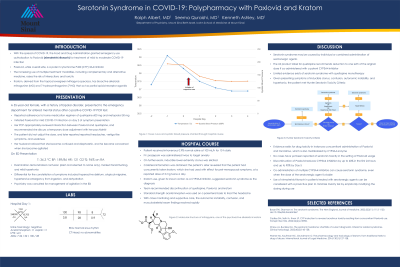Psychopharmacology and Toxicology
Session: Poster Session
(146) Serotonin Syndrome in COVID-19: Polypharmacy with Paxlovid and Kratom

Trainee Involvement: Yes
- RA
Ralph Albert, MD
Resident Physician
Mount Sinai Beth Israel
New York, New York, United States - SQ
Seema Quraishi, MD
Division Chief and Fellowship Program Director, Consultation-Liaison Psychiatry
Mount Sinai Beth Israel
Astoria, New York, United States 
Kenneth Ashley, MD, FACLP, DLFAPA
Associate Professor
Mount Sinai Beth Israel
New York, New York, United States
Presenting Author(s)
Co-Author(s)
Background/Significance Discussion Conclusion/Implications References Boyer EW, Shannon M. The serotonin syndrome. The New England Journal of Medicine. 2005;352(11):1112-1120. doi:10.1056/NEJMra041867 Cadley SM, Sethi A, Knorr JP. CYP induction to reverse tacrolimus toxicity resulting from concomitant Paxlovid use. Transpl Infect Dis. 2022;24(6):e13982. Warner ML, Kaufman NC, Grundmann O. The pharmacology and toxicology of kratom: from traditional herb to drug of abuse. International Journal of Legal Medicine. 2016;130(1):127-138.
With the spread of COVID-19, the Food and Drug Administration granted emergency use authorization to Paxlovid (nirmatrelvir/ritonavir) for treatment of mild to moderate COVID-19 infection. Paxlovid, while overall safe, is a potent cytochrome P450 (CYP) 3A4 inhibitor. The increasing use of multiple treatment modalities, including complementary and alternative medicine, by patients throughout the lifespan raises the risk of interactions and toxicity. Here, we report a case of serotonin syndrome in a patient initiated on Paxlovid while taking a stable dose of quetiapine, with further investigation revealing kratom (Mitragyna speciosa) use.
Case
A 55-year-old female, with a history of bipolar disorder, presented to the emergency department for altered mental status after a positive COVID-19 PCR test. One day after initiating Paxlovid, she appeared confused and diaphoretic. Home medications included quetiapine 600 mg and metoprolol 50 mg. Her vital signs were significant for labile blood pressure and tachycardia, though she remained afebrile. Examination revealed confusion, marked facial flushing, persistent horizontal eye movements, mild hypertonia, and hyperreflexia. There was no upper or lower extremity myoclonus present. Laboratory testing was unremarkable aside from mild leukocytosis, and urine toxicology was negative. Further interview revealed use of kratom supplements for perimenopausal symptoms. Kratom use, given its known action as a CYP3A4 inhibitor (Warner 2016), suggested serotonin syndrome as the diagnosis. The team recommended discontinuation of quetiapine, Paxlovid, and kratom. With close monitoring and supportive care, the autonomic instability, confusion, and ocular and musculoskeletal exam findings resolved rapidly.
Serotonin syndrome may be caused by individual or combined administration of serotonergic agents. Limited evidence exists of serotonin syndrome caused by quetiapine monotherapy, though the US product label for quetiapine recommends reduction to one sixth of the original dose if co-administered with a potent CYP3A4 inhibitor. In this case, evidence of serotonin syndrome rapidly emerged with initiation of Paxlovid and kratom. Given presenting symptoms of ocular clonus, confusion, autonomic instability, and hyperreflexia, the patient met Hunter Serotonin Toxicity Criteria (Boyer 2005). Evidence exists for drug toxicity in other instances of concomitant administration of Paxlovid (Cadley 2022), but Paxlovid has not previously been implicated as a causative factor for serotonin syndrome.
Caution should be used in patients of all ages to avoid potentially harmful polypharmacy. Kratom, a herbal supplement with opioid and stimulant effects, has seen use in a diverse population as an alternative to opioids but presents new risks if used concomitantly with serotonergic agents. .As this case illustrates, use of multiple CYP3A4 inhibitors can cause serotonin syndrome, even when the dose of the serotonergic agent is stable.

